Many cat owners struggle with cats who want to scratch the furniture, drapes, and carpeting. However, before declawing your cat, consider using one or more time-proven techniques to train your kitty to scratch only where you want her to.
First we must understand why cats scratch. Your cat's DNA is still programmed to catch prey, and scratching also sharpens his claws so that he can "provide for himself." In doing this, the claw's outer sheath falls away to reveal a new, sharper claw that has grown underneath (much like a snake shedding its skin).
When a cat scratches, he is also marking his home by releasing pheromones (chemicals that trigger responses in other cats) that are stored in his paw pads. Pheromones are undetectable by humans but other felines can tell where your cat's territory is. (Cats also have these glands in their cheeks, which is why they rub anything new or old that they feel belongs to them - including you!)
And sometimes a good scratch just feels good.
So...because we can't suppress our cats' natural instincts, how can we direct them to scratch in the right place?
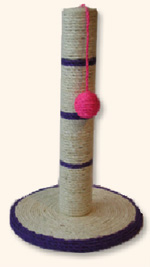 1. Scratching Posts are essential to a cat's environment. Even if your cat goes outdoors, he must be provided at minimum with a scratching post inside the house. Preferable is a post in multiple areas of the house, particularly by areas that your cat is prone to scratch (example: curtains, furniture, mattresses, etc). Research shows that cats' favorite scratching materials are sisal rope or matting or cardboard; they actually prefer these types of scratching posts to carpet or furniture because these surfaces mimic the texture of tree bark that would be their natural outdoor choice. (In fact, some specialty companies make scratching posts with wood or actual tree branches). Posts made from carpet or fabric are usually not recommended as they may train your cat to scratch similar surfaces.
1. Scratching Posts are essential to a cat's environment. Even if your cat goes outdoors, he must be provided at minimum with a scratching post inside the house. Preferable is a post in multiple areas of the house, particularly by areas that your cat is prone to scratch (example: curtains, furniture, mattresses, etc). Research shows that cats' favorite scratching materials are sisal rope or matting or cardboard; they actually prefer these types of scratching posts to carpet or furniture because these surfaces mimic the texture of tree bark that would be their natural outdoor choice. (In fact, some specialty companies make scratching posts with wood or actual tree branches). Posts made from carpet or fabric are usually not recommended as they may train your cat to scratch similar surfaces.
It is very important to consider putting a bit of extra money into a truly quality scratching post. Many posts are short and poorly constructed; the sisal is cheaply glued and the posts themselves are made from cardboard or lightweight plastic tubing and easily tip over.
In the wild, cats would stretch out to full length to scratch, and most scratching posts today are almost 2/3rds too short for this. But three very similar posts are exemplary in their construction:
Each is approximately 30-32" tall, have a solid wood base and post, and are covered with sisal fabric, and organic tight-weave fiber that cats love to sink their claws into. Though they are a little pricey ($60.00 average), that's a lot less expensive than a damaged sofa, antique covered chair, or hand-made quilt.
Still have problems with scratching? Before giving up, try flat and angled scratchers as well, and make sure you've given your cat a choice of surfaces (sisal, sisal fabric, cardboard, etc) to choose from. Like people, cats are individuals with unique preferences.
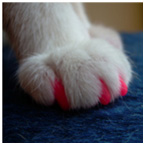 2. SoftPaws (alternately sold as SoftClaws) is the newest alternative to declawing. These soft, flexible vinyl caps are slipped onto your cats claws every 4-6 weeks. They are relatively inexpensive (about $20.00 per pack of 40, which will last 5 applications if only applied to the front paws) and come in a variety of colors, including clear. SoftPaws was developed by a veterinarian and has saved millions of cats from declawing. They are sold in most major pet stores and can also be purchased online (SoftPaws or SoftClaws). These websites have informative FAQ and Testimonial pages.
2. SoftPaws (alternately sold as SoftClaws) is the newest alternative to declawing. These soft, flexible vinyl caps are slipped onto your cats claws every 4-6 weeks. They are relatively inexpensive (about $20.00 per pack of 40, which will last 5 applications if only applied to the front paws) and come in a variety of colors, including clear. SoftPaws was developed by a veterinarian and has saved millions of cats from declawing. They are sold in most major pet stores and can also be purchased online (SoftPaws or SoftClaws). These websites have informative FAQ and Testimonial pages.
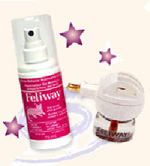 3. Feliway and Comfort Zone are two innovative products that mimic the pheromones that your cat naturally produces when scratching. These sprays (also available in air diffusers) are used both for calming anxious cats and to discourage scratching. When an area is exposed to Feliway/Comfort Zone, the cat considers the area already "marked" and does not feel the need to leave her scent. These products are carried in major pet stores, veterinarian offices, and even large retailer chains like Wal-Mart. They are safe for people and animals, but should not be sprayed directly on cats.
3. Feliway and Comfort Zone are two innovative products that mimic the pheromones that your cat naturally produces when scratching. These sprays (also available in air diffusers) are used both for calming anxious cats and to discourage scratching. When an area is exposed to Feliway/Comfort Zone, the cat considers the area already "marked" and does not feel the need to leave her scent. These products are carried in major pet stores, veterinarian offices, and even large retailer chains like Wal-Mart. They are safe for people and animals, but should not be sprayed directly on cats.
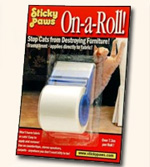 4. StickyPaws is an odorless, double-sided tape that cats don't like the feel of under their paws. It can be used on countertops, furniture, or virtually any other off-limits surface. It is recommended that tape be replaced every 4-6 weeks or until the unwanted behavior has stopped. StickyPaws retails anywhere from $14 per roll or $20 for several sheets.
4. StickyPaws is an odorless, double-sided tape that cats don't like the feel of under their paws. It can be used on countertops, furniture, or virtually any other off-limits surface. It is recommended that tape be replaced every 4-6 weeks or until the unwanted behavior has stopped. StickyPaws retails anywhere from $14 per roll or $20 for several sheets.
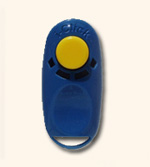 5. Clicker Training is a longer-term training tool that can be applied to many behaviors, including scratching. It is a positive reinforcement program that focuses on rewarding pleasing behaviors rather than punishing negative ones. It is widely used on many animals including dogs, cats, horses, dolphins, birds, and even fish, and many books, articles and support groups are available on clickertraining.com.
5. Clicker Training is a longer-term training tool that can be applied to many behaviors, including scratching. It is a positive reinforcement program that focuses on rewarding pleasing behaviors rather than punishing negative ones. It is widely used on many animals including dogs, cats, horses, dolphins, birds, and even fish, and many books, articles and support groups are available on clickertraining.com.
A final note on declawing: while many people believe that declawing is an acceptable solution, most of the world now believes that this practice is cruel. There is a tremendous amount of information available through books and websites that offer great information explaining the procedure and alternatives to declawing. There are many already declawed adults waiting for a new home through Petfinder.com if we don't have one who fits what you're looking for at PAWS.

